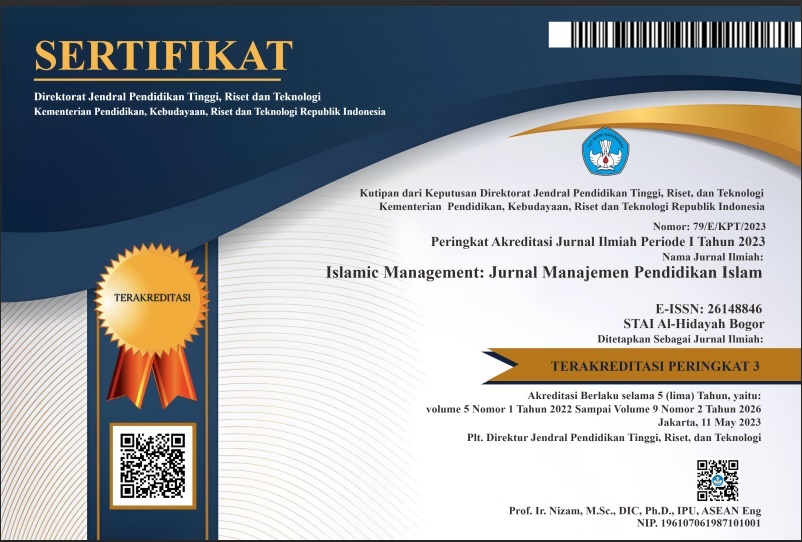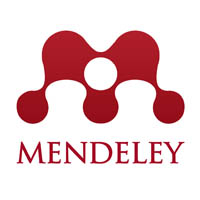DESIGNING AND IMPLEMENTATION OF A BLENDED LEARNING MODEL IN MPI STUDY PROGRAM
DOI:
https://doi.org/10.30868/im.v8i02.8596Keywords:
Blended Learning, Learning Model, Development, Effectiveness, Islamic Education Management.Abstract
In response to the growing demand for flexible and high-quality learning, this study developed and tested a contextual and adaptive blended learning model for the Islamic Education Management (MPI) Study Program at the Faculty of Tarbiyah and Teacher Training, UIN Sunan Gunung Djati Bandung. The aim was to design a model that aligns with the academic needs of MPI students while incorporating digital tools effectively.
Using a Research and Development (R&D) method based on a modified Borg & Gall model, the study progressed through seven stages, from initial analysis to final implementation. Data were collected through observations, interviews, questionnaires, documentation, and learning outcome tests (pre-test and post-test), involving 14 lecturers and two student cohorts in semesters IV and VI. The developed model integrated 60% online and 40% offline learning, using e-knows LMS, Google Meet, YouTube, and project-based learning strategies. Results showed significant improvement in student learning outcomes and increased engagement, as confirmed by t-test analysis. The study concludes that the blended learning model is effective, contextually relevant, and meets the need for adaptive education. Further research is recommended to apply the model in other courses, explore the integration of AI-based technologies, and conduct longitudinal analysis to assess its long-term impact.
References
Abdullah, M. Z., Hakim, M. A., & Salsabila, U. H. (2022). Pentingnya Memperkuat Eksistensi Pendidkan Islam Era ERA 4.0. EL-HIKMAH: Jurnal Kajian Dan Penelitian Pendidikan Islam. https://doi.org/10.20414/elhikmah.v15i2.4194
Aisy, S. R., & Hudaidah, H. (2021). Pendidikan Indonesia Di Era Awal Kemerdekaan Sampai Orde Lama. EDUKATIF : JURNAL ILMU PENDIDIKAN. https://doi.org/10.31004/edukatif.v3i2.327
Aka, K. A. (2019). Integration Borg & Gall (1983) and Lee & Owen (2004) models as an alternative model of design-based research of interactive multimedia in elementary school. Journal of Physics: Conference Series. https://doi.org/10.1088/1742-6596/1318/1/012022
Amiti, F. (2020). Synchronous And Asynchronous E-Learning. European Journal of Open Education and E-Learning Studies. https://doi.org/10.46827/ejoe.v5i2.3313
Azizi, S. M., Roozbahani, N., & Khatony, A. (2020). Factors affecting the acceptance of blended learning in medical education: application of UTAUT2 model. BMC Medical Education. https://doi.org/10.1186/s12909-020-02302-2
Badrudin, B., & Nurdin, R. (2019). SIM (Sistem Informasi Manajemen) Kurikulum Perguruan Tinggi Keagamaan Islam Berbasis Cms Wordpress. Ta’dib. https://doi.org/10.31958/jt.v22i1.1416
Bizami, N. A., Tasir, Z., & Kew, S. N. (2023). Innovative pedagogical principles and technological tools capabilities for immersive blended learning: a systematic literature review. Education and Information Technologies. https://doi.org/10.1007/s10639-022-11243-w
Chukhray, N., Mrykhina, O., & Izonin, I. (2022). Holistic Approach to R&D Products’ Evaluation for Commercialization under Open Innovations. Journal of Open Innovation: Technology, Market, and Complexity. https://doi.org/10.3390/joitmc8010009
Corey, L., Mascola, J. R., Fauci, A. S., & Collins, F. S. (2020). A strategic approach to COVID-19 vaccine R&D. Science. https://doi.org/10.1126/science.abc5312
Cronje, J. C. (2020). Towards a new definition of blended learning. Electronic Journal of E-Learning. https://doi.org/10.34190/EJEL.20.18.2.001
El-Sapa, S., Almoneef, A. A., Lotfy, K., A. El-Bary, A., & Saeed, A. M. (2022). Moore-Gibson-Thompson theory of a non-local excited semiconductor medium with stability studies. Alexandria Engineering Journal. https://doi.org/10.1016/j.aej.2022.05.036
Fàbregues, S., Paré, M. H., & Meneses, J. (2019). Operationalizing and Conceptualizing Quality in Mixed Methods Research: A Multiple Case Study of the Disciplines of Education, Nursing, Psychology, and Sociology. Journal of Mixed Methods Research. https://doi.org/10.1177/1558689817751774
Goldstein, E. A., Merrick, M. J., & Koprowski, J. L. (2018). Low survival, high predation pressure present conservation challenges for an endangered endemic forest mammal. Biological Conservation. https://doi.org/10.1016/j.biocon.2018.02.030
Hamzah, Tambak, S., Hamzah, M. L., Purwati, A. A., Irawan, Y., & Umam, M. I. H. (2022). Effectiveness of Blended Learning Model Based on Problem-Based Learning in Islamic Studies Course. International Journal of Instruction. https://doi.org/10.29333/iji.2022.15242a
Heinbach, D. (2022). Storytelling (Online Discussions/Discussion Quality). DOCA - Database of Variables for Content Analysis. https://doi.org/10.34778/5w
Jebb, A. T., Ng, V., & Tay, L. (2021). A Review of Key Likert Scale Development Advances: 1995–2019. Frontiers in Psychology. https://doi.org/10.3389/fpsyg.2021.637547
Jones, D. A. (2023). A Review and Critical Analysis of Qualitative Methodologies and Data-Collection Techniques Used for Code-Switching Research. American Journal of Qualitative Research. https://doi.org/10.29333/ajqr/12988
Lestari, S. D., & Maunah, B. (2022). Dasar - Dasar Yuridis Sistem Pendidikan Nasional. Jurnal Ilmu Pendidikan Sekolah Dasar. https://doi.org/10.19184/jipsd.v9i3.31876
Li, X., Yang, Y., Chu, S. K. W., Zainuddin, Z., & Zhang, Y. (2022). Applying blended synchronous teaching and learning for flexible learning in higher education: an action research study at a university in Hong Kong. Asia Pacific Journal of Education. https://doi.org/10.1080/02188791.2020.1766417
Marlina, Y. (2022). A Conceptualization of Online Collaborative English Learning for Undergraduate Students in the New Normal Post Covid-19 Era. EDUTEC : Journal of Education And Technology. https://doi.org/10.29062/edu.v5i3.317
Maydiantoro, A. (2021). Model Penelitian Pengembangan (Borg & Gall, 1983). Jurnal Pengembangan Profesi Pendidik Indonesia.
Moorhouse, B. L., & Wong, K. M. (2022). Blending asynchronous and synchronous digital technologies and instructional approaches to facilitate remote learning. Journal of Computers in Education. https://doi.org/10.1007/s40692-021-00195-8
Morantz, T., & Costopoulos, A. (2021). BRUCE GRAHAM TRIGGER (1937-2006). Recherches Amérindiennes Au Québec. https://doi.org/10.7202/1081870ar
Mumu, J., Tanujaya, B., Charitas, R., & Prahmana, I. (2022). Likert Scale in Social Sciences Research: Problems and Difficulties. FWU Journal of Social Sciences. https://doi.org/10.51709/19951272/Winter2022/7
Mutasar, A., Masril, M., David, D., Hendriani, S., & Fitriani, W. (2019). Pengaruh Kecerdasan Emosional Dan Kepribadian Terhadap Kepemimpinan Kepala Madrasah Di Kabupaten Agam. Al-Fikrah: Jurnal Manajemen Pendidikan. https://doi.org/10.31958/jaf.v7i2.1590
Olugbo, M. A., Obienu, A. C., & Amadin, F. I. (2023). Impact of Effective Communication on Institutional Performance: Case Study in Higher Learning Institutions. Journal of Education, Society and Behavioural Science. https://doi.org/10.9734/jesbs/2023/v36i101264
P., G. (2021). Memahami Tujuan dan Fungsi Pendidikan di Indonesia. 2021.
Park, J. H., & Shin, K. (2018). Efficiency of government-sponsored R & D projects: A metafrontier DEA approach. Sustainability (Switzerland). https://doi.org/10.3390/su10072316
Putri, S. N., Anak Agung Gede Agung, & I Kadek Suartama. (2023). E-module with the Borg and Gall Model with a Contextual Approach to Thematic Learning. Journal for Lesson and Learning Studies. https://doi.org/10.23887/jlls.v6i1.57482
Rukiyati, R. (2020). Tujuan pendidikan nasional dalam perspektif Pancasila. HUMANIKA. https://doi.org/10.21831/hum.v19i1.30160
Sefriani, R., Sepriana, R., Wijaya, I., Radyuli, P., & Menrisal. (2021). Blended learning with edmodo: The effectiveness of statistical learning during the covid-19 pandemic. International Journal of Evaluation and Research in Education. https://doi.org/10.11591/IJERE.V10I1.20826
Shakeel, S. I., Haolader, M. F. A., & Sultana, M. S. (2023). Exploring dimensions of blended learning readiness: Validation of scale and assessing blended learning readiness in the context of TVET Bangladesh. Heliyon. https://doi.org/10.1016/j.heliyon.2022.e12766
Sharma, L., & Srivastava, M. (2020). Teachers’ motivation to adopt technology in higher education. Journal of Applied Research in Higher Education. https://doi.org/10.1108/JARHE-07-2018-0156
Simplilearn. (2022). What Is Data Collection: Methods, Types, Tools, and Techniques. Simplilearn.
Sumarmi, Bachri, S., Irawan, L. Y., & Aliman, M. (2021). E-module in blended learning: Its impact on students’ disaster preparedness and innovation in developing learning media. International Journal of Instruction. https://doi.org/10.29333/iji.2021.14412a
Syaiviana, I., Sari, I. Y., Adinda, P., Pratiwi, V. B., & Anggraini, W. (2023). Pengembangan Modul Pembelajaran Matematika Berbasis Web Berdasarkan Langkah Borg and Gall. Trigonometri: Jurnal Matematika Dan Ilmu Pengetahuan Alam.
Takona, J. P. (2024). Research design: qualitative, quantitative, and mixed methods approaches / sixth edition. Quality and Quantity. https://doi.org/10.1007/s11135-023-01798-2
Thomas, R. M., & Brubaker, D. L. (2024). Data Collection Techniques and Instruments. In Theses and Dissertations. https://doi.org/10.5040/9798216025450.ch-008
Untoroseto, D., & Triayudi, A. (2023). Analysis of Blended Learning Development in Distance Learning in Variation of Borg & Gall and Addie Models. Journal La Multiapp. https://doi.org/10.37899/journallamultiapp.v4i6.973
Varkey, T. C., Varkey, J. A., Ding, J. B., Varkey, P. K., Zeitler, C., Nguyen, A. M., … Thomas, C. R. (2023). Asynchronous learning: a general review of best practices for the 21st century. Journal of Research in Innovative Teaching and Learning. https://doi.org/10.1108/JRIT-06-2022-0036
Weyant, E. (2022). Research Design: Qualitative, Quantitative, and Mixed Methods Approaches, 5th Edition. Journal of Electronic Resources in Medical Libraries. https://doi.org/10.1080/15424065.2022.2046231
Downloads
Published
How to Cite
Issue
Section
Citation Check
License
Copyright (c) 2025 Badrudin Badrudin, Supiana Supiana, Yuli Marlina

This work is licensed under a Creative Commons Attribution-ShareAlike 4.0 International License.
Authors who publish with this journal agree to the following terms:
- Authors retain copyright and grant the journal right of first publication with the work simultaneously licensed under a Creative Commons Attribution License that allows others to share the work with an acknowledgment of the work's authorship and initial publication in this journal.
- Authors are able to enter into separate, additional contractual arrangements for the non-exclusive distribution of the journal's published version of the work (e.g., post it to an institutional repository or publish it in a book), with an acknowledgment of its initial publication in this journal.
- Authors are permitted and encouraged to post their work online (e.g., in institutional repositories or on their website) prior to and during the submission process, as it can lead to productive exchanges, as well as earlier and greater citation of published work (See The Effect of Open Access).






